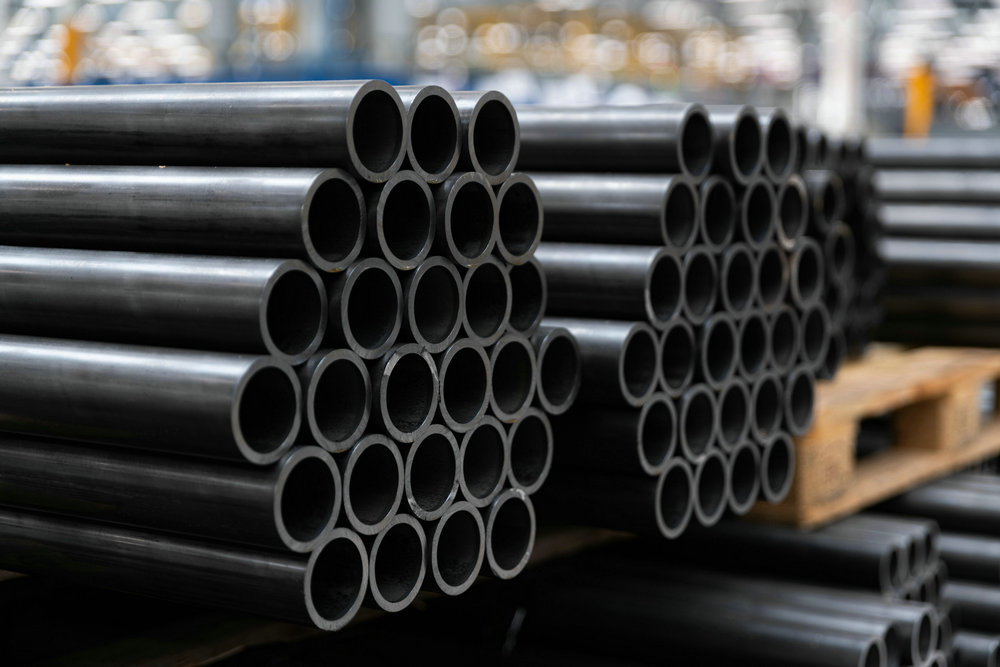
A steel pipe is a steel product with a hollow cross-section and a length much greater than its diameter or circumference. As one of the most essential metal materials in modern industrial society, steel pipes play an irreplaceable role in economic and social development. From energy extraction to construction structures, from machinery manufacturing to daily life—steel pipes are everywhere.
Based on production processes, steel pipes are mainly divided into two categories:
Seamless Steel Pipes: Produced by directly piercing and rolling a steel billet without any weld seam.
Welded Steel Pipes: Made by rolling steel plates or strips into shape and welding the edges together.
Carbon steel is the most commonly used material for manufacturing steel pipes. Based on carbon content, it can be classified as:
Low Carbon Steel (<0.25%): e.g., 20# steel — good plasticity and weldability, used for fluid transport and structural purposes.
Medium Carbon Steel (0.25–0.60%): e.g., 45# steel — higher strength, used for mechanical parts.
High Carbon Steel (>0.60%): high hardness and wear resistance, suitable for tools and special components.
Alloy steel enhances performance by adding alloying elements. Common types include:
Chromium-Molybdenum Steel (15CrMoG): high-temperature and hydrogen corrosion resistance, used in power plant boilers.
Manganese Steel (16Mn): high strength and toughness, used for pressure vessels.
Nickel-Chromium Steel (304 Stainless Steel): excellent corrosion resistance, used in chemical and food industries.
These pipes are primarily known for corrosion resistance. Common types include:
Austenitic Stainless Steel (304, 316 series): excellent all-around performance and the most widely used.
Ferritic Stainless Steel (430 series): good resistance to stress corrosion.
Duplex Stainless Steel (2205 series): high strength and superior corrosion resistance.
Hot Rolling: Heating billet → Piercing → Rolling → Sizing → Cooling → Straightening
Cold Drawing: Cold working of hot-rolled pipes for better dimensional accuracy and surface finish.
Extrusion: Suitable for high-alloy or hard-to-deform metals.
Longitudinal Submerged Arc Welding (LSAW): Forming and welding steel plates — for large-diameter, high-pressure pipelines.
Spiral Submerged Arc Welding (SSAW): Spiral forming and welding — for large-diameter, medium- and low-pressure pipelines.
Electric Resistance Welding (ERW): Continuous forming and high-frequency welding — for small- and medium-diameter pipes.
Oil & Gas Transmission: API 5L line pipes (e.g., X80 grade used in the West-East Gas Pipeline Project).
Power Plants: High-pressure seamless pipes (GB 5310 standard) for boilers.
Nuclear Industry: Nuclear-grade stainless steel pipes requiring top safety and reliability.
Steel Structures: Rectangular and square welded pipes as beam and column materials.
Scaffolding: Welded pipes with good strength and toughness.
Bridges: Large-diameter thick-walled steel pipes for piers and deck supports.
Hydraulic Systems: Cold-drawn precision seamless tubes for high dimensional accuracy.
Bearing Manufacturing: Bearing steel pipes requiring high purity and uniform structure.
Automotive Industry: Seamless pipes for drive shafts, welded pipes for exhaust systems.
Water Supply & Drainage: Galvanized and stainless steel pipes.
Furniture and Decoration: Various structural and decorative pipes.
Fitness Equipment: Structural and mechanical pipes.
Corrosive Environment: Choose stainless or weather-resistant steel pipes.
High-Temperature Environment: Use alloy steel pipes.
Low-Temperature Environment: Choose steel pipes with good impact toughness.
Pressure Resistance: Select wall thickness and steel grade according to working pressure.
Strength: Choose the appropriate material strength grade.
Toughness: Determine impact energy according to service temperature.
Select cost-effective products under performance requirements:
General structures: welded pipes are economical.
High-pressure service: seamless pipes are preferred.
Special media: corrosion-resistant materials are required.
Promote energy-saving, environmentally friendly production to reduce emissions and develop a circular economy.
Adopt Industry 4.0 technologies for automation and digitalization to ensure stable product quality.
Provide tailor-made products and solutions based on specific user needs.
Steel pipes are fundamental industrial materials that reflect a nation’s level of industrialization. From ordinary water supply lines to challenging deep-sea pipelines, and from simple furniture tubes to aerospace components, steel pipes—with their variety and reliability—continue to provide a solid foundation for human progress. As new materials, technologies, and processes emerge, the steel pipe industry is evolving toward a smarter, greener, and more sustainable future.
